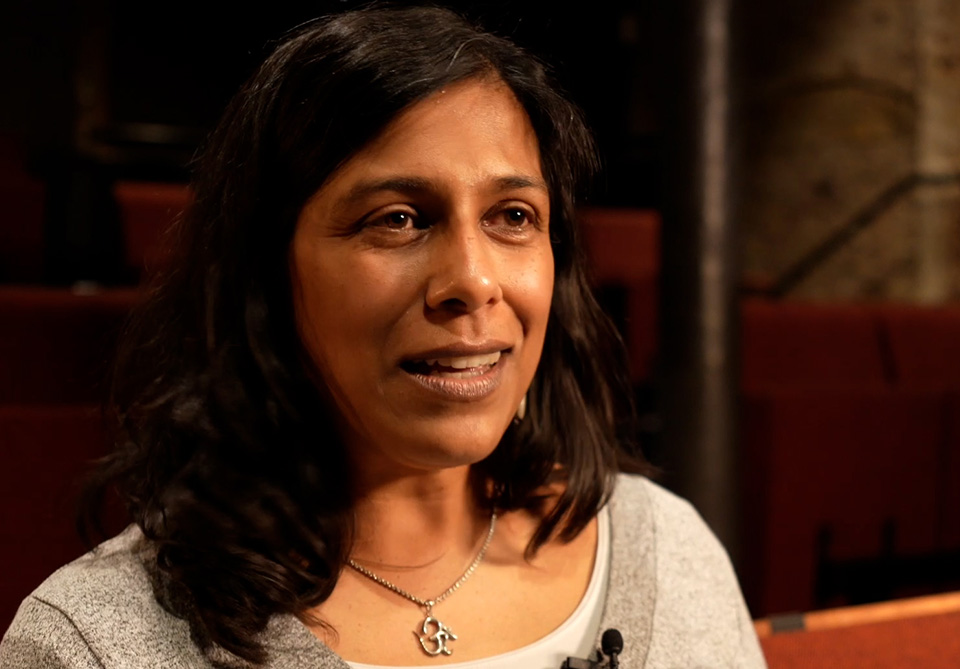An interview with playwright Lolita Chakrabarti in conversation with Hymn dramaturg Kamesha Khan.
“Sympathetic resonance is when a tuning fork vibrates because it feels the vibration of another tuning fork without ever touching it”

KAMESHA KHAN: What inspired you to write this play?
LOLITA CHAKRABARTI: I really wanted to see two Black leading men playing opposite one another, and to see what sparks would fly. I also wanted to explore the oftenunseen nuance of a relationship between straight men—the insecurity, fussiness, vanity, fun, and affection that I’ve seen between my male friends. I hadn’t seen that on stage before, a play of equals.
KK: Given that the story centers on two men, Benny and Gil, the title invites consideration of its homophone: him. What is the relationship between these two words, and how do you see their meanings playing out?
LC: The title conjures up music and men. I knew it was a play for two male actors and that music was going to be part of it. I love how music can transport you back in time. Music and memory are very linked. I learned about sympathetic resonance, which is when a tuning fork vibrates because it feels the vibration of another tuning fork without ever touching it, they share a harmonic likeness. I thought wow, what a beautiful idea. You have these two characters who can tune into each other and sing each other’s tune. Music and men.
KK: Can you tell us about your process of relocating this play to Chicago?
LC: I always thought the play would work beautifully in America. British and American people of color have a similar standing in society I think, but our history and navigation of life is very different. In Britain, most of us are second-generation with immigrant parents whereas in America your history goes back further, is deeper, and more brutal. These two versions of migration and subsequent integration make for really different stories. So, in transposing the play to Chicago, it has changed.
When I approached Artistic Director Edward Hall and suggested relocating the play to Chicago, he brought me over to the city to do some invaluable and intensive research. I met the Music Director at Trinity United Church of Christ, and went to a Sunday service. It was extraordinary! What really struck me was the social justice aspect, which is very different from the services I attended as a kid. That really changed my feelings for the character of Gil. I also went to the DuSable Museum and Grant Park, did a walking tour of Hyde Park and Kenwood, enjoyed dinner in Bronzeville, and experienced my first chicken and waffles!
In the play, there is a statue that has been torn down because of conflicting public opinion and colonial history. This was based on the statue of Edward Colston, a wealthy Victorian merchant and slave trader. When people In Bristol found out about Colston’s background, they tore down his statue. The outrage was surprising because people were demanding its return. So, I needed an equivalent in Chicago. I quickly got the same answer from everyone: the Christopher Columbus statues. I went to Grant Park and saw the empty pedestal. There was nothing there, that’s a whole story in itself. The communities demanding its return are different, but the arguments are similar. It was fascinating to get a flavor of the richness of Chicago’s culture.
KK: There are several offstage female characters that we never see whose backstories reveal a lot about Gil and Benny. Why did you decide to keep them invisible, and how does their absence enhance the storytelling?
LC: It was important to me that I made this world real and far-reaching. The world doesn’t work without women, we are the mothers, sisters, wives, colleagues, and workers of the world. The women’s contribution is vitally important to the story. In some ways, they feel more powerful for not being seen because we see them through the eyes of the men. They feel imposing and strong. I like that.
KK: You’ve described Hymn as an exploration of men falling in love in a way that is neither physical nor romantic. Why was it important for you to tell a story about this kind of male intimacy?
LC: When the play was on in London, I had so many men—friends, acquaintances, and even strangers—contact me to say thank you, they felt the story reflected them. I didn’t realize that it was hitting something that really isn’t dealt with because we are often looking at men as the authoritarians, the leaders of the story. Many are not. I have noticed a lot of my male friends are aware of how they might be judged so they contain their frustrations in public. With this play, I wanted to see two Black middle-aged men just be honest and be themselves.
KK: Why present Hymn now, in 2025?
LC: There is so much divisive separation, judgment, and prejudice now, even within groups that used to be united. I hope this story of two opposing individuals who meet each other, and find a deep common bond, reminds us of the importance of connection. It is a simple tale of cooperation and care, a universal story of finding commonality and love. I want the audience to travel emotionally, to really engage with these men, and understand their lives. And perhaps see a little of themselves too.